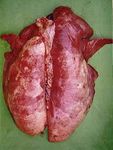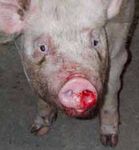Top 10 Pig Conditions Part 1 - 5 Of Zuku's Top Pig Conditions To Know For NAVLE Success: Zuku Review
←
→
Page content transcription
If your browser does not render page correctly, please read the page content below
Top 10 Pig Conditions Part 1
5 Of Zuku's Top Pig Conditions To Know For NAVLE® Success:
1. Erysipelas
Classic case: Sporadic, occasional outbreaks
Acute:
Excessive squealing when handled
Sudden/unexpected death (esp. growers
and finishers)
Fever
Joint pain
Skin lesions vary - generalized cyanosis (purple ears!)
to classic diamond skin (rhomboid urticaria) lesions
Rhomboid skin lesions of erysipelas
Chronic:
Enlarged joints and lameness
Vegetative valvular endocarditis
Dx:
Etiology: Erysipelothrix rhusiopathiae, a gram-positive,
aerobic bacillus bacterium with at least 28 serotypes
Outbreak: Skin lesions and lameness are strongly
suggestive
Single acute or chronic cases: Cellular and colonial morphology of
Culture E. rhusiopathiae from blood Erysipelothrix rhusiopathiae
PCR on blood or tissue samples
Rapid response to penicillin
Tissue immunohistochemistry
Serology: Helps distinguish previous exposure or evaluate
success of vaccines
Rx:
Acute cases:
Penicillin: q12h for ≥ 3 d
Tetracyclines in water if large number affected Synovitis and arthritis in chronic
+/- NSAIDs for fever erysipelas
Chronic cases: Treatment rarely successful and not cost
effective
Vaccination:
Very effective!
Give around time of weaning because it's stressful
Booster pigs kept for breeding herd
Pearls:
Excreted in feces and oronasal secretions
Pigs become infected by ingestion or skin abrasions
Half the pigs in intensive swine operations have colonized tonsils and are silent shedders
(healthy carriers)
Can occur in turkeys, wild birds, and lambs
Resistant to many environmental effects
2. Hog cholera (a.k.a. classical swine fever)
Classic case: Clinical signs vary with strain and host factorsCan affect all age groups
High fever, lethargy
Yellowish diarrhea, vomiting
Internal HEMORRHAGE, many organs-larynx,
body wall, bladder, kidneys
Vasculitis: Purple discoloration or erythema of ears, lower
abdomen, and extremities
Ataxia
Poor reproductive performance in sows
Can be acute, subacute, or chronic causing death within Blue ears typical of hog cholera
10, 20-30, or unlimited days, respectively
Dx:
Etiology: Highly contagious RNA Pestivirus (family
Flaviviridae)
Virus isolation or antigen detection (fluorescent antibody)
on tonsils, lymph nodes, spleen, kidney, nasal swabs,
ileum, or whole blood
Viral RNA detection via RT-PCR on nasal swab or tonsil
scraping
Turkey egg kidneys in necropsy of pig
Serology via virus neutralization with hog cholera
CBC: Leukopenia
Necropsy: Turkey egg kidneys
Rx: None!
If hog cholera-free country: Cull and quarantine
Endemic countries: +/- Vaccination
Pearls: REPORTABLE!
Prognosis:
Poor
Morbidity and mortality can reach 100%
Eradicated in US in 1976
Use vaccines for prevention in endemic countries only
Economically important and seen worldwide
"Evil Twin": African swine fever is clinically indistinguishable
3. Mycoplasmal pneumonia (enzootic pneumonia)
Classic case:
If endemic: Morbidity high
Cough, pneumonia
Slow growth, feed inefficiency
Stress leads to outbreak
More severe in naïve herds
Carrier pigs spread to naïve pigs
Dx:
Etiology: Mycoplasma hyopneumoniae, a fastidious,
small, pleomorphic organism
Identification of M. hyopnuemoniae on impression smear
of cut lung
Fluorescent antibody
PCR on nasal/bronchial swabs: Very sensitive and
specific
Lung consolidation secondary to
Culture: Tricky because fastidious organism enzootic pneumonia.
Herd serology: Difficult to interpret Image used with permission, courtesy
Rx: of The Pig Site
Acute disease in naïve herds or single pigs: Antibiotics!
Prevention/control
Vaccinate sows before farrowingManagement: Improve ventilation, avoid overcrowding, all-in-all-out, biosecurity
Rapidly inactivated by most disinfectants
Pearls:
COMMON! 30-80% of pigs at slaughter have signs in lungs
Frequently complicated by other infectious agents (e.g., Pasteurella multocida, porcine
respiratory disease complex, influenza)
Can travel windborne more than a mile!
M. hyosynoviae causes epidemic synovitis in growers
M. hyorhinis causes fibrinous polyserositis in young pigs
4. Atrophic rhinitis
Classic case: Low levels in herds are common
Acute: 3-6 wks age
Sneezing, coughing
Epistaxis
Blocked tear ducts with tear staining
Impaired growth rate and feed conversion
Chronic: Snout laterally deviated or shortened
Dx:
Etiology is combination of:
Bordatella bronchiseptica
Toxigenic Pasteurella multocida
Management factors: Ventilation, sanitation,
overstocking Atrophic rhinitis causes epistaxis
Clinical signs almost pathognomonic
Bacterial cultures/PCR from nasal swabs of affected pigs
Herd monitoring: "Atrophy score"
Measure turbinate atrophy at level of 2nd premolar at
7-9 mos of age
Rx: None, prevent or control
If levels of disease rise:
Chemoprophylaxis: To sows before farrowing, to
newborns, and to newly weaned pigs
Vaccination: Sows (4 and 2 wks before farrowing) and
piglets (at age 1 and 4 wks)
Temporarily close herd to new pigs Snout deviation in chronic atrophic
Management changes rhinitis
Improve ventilation and hygiene
Decrease dust in feed
Pearls:
Nonprogressive atrophic rhinitis:
B. bronchiseptica
Mild, transient
Minimal long-term effects
Progressive atrophic rhinitis:
Toxigenic P. multocida
Severe Atrophic rhinitis causes damage to the
Permanent, stunted growth nasal turbinates.
No longer a major health risk in US Images used with permission,
Severity in herd depends on if toxigenic P. multocida courtesy of The Pig Site
involved and herd immune status
Introduced into herd by new pigs (esp. inapparent
carriers!)
5. Zearalenone toxicosis
Classic case:Weaned and prepubertal gilts:
Hyperemic and enlarged vulva (i.e.,
"vulvovaginitis")
Enlarged uterus and mammary glands
Severe: Prolapsed uterus
Mature sows:
Pseudopregnancy if fed at d 12-14 of estrous cycle Sow with enlarged mammary glands
Early embryonic death if fed early in gestation as seen with zearalenone toxicosis
Boars: Infertility
Dx:
Etiology: Fusarium graminearum, a mold that commonly
infects corn, wheat, barley, oats, and sorghum, produces
the mycotoxin
History of diet-related occurrence
Classic clinical signs
Rule out differential reproductive infections or
diethylstilbestrol in feed
Suspected feed: Chemical analysis or mice bioassay Wheat is commonly infected with
Rx: Fusarium graminearum
Signs resolve 1-4 wks after stopping feed
Except multiparous sows may be anestrus for 8-10
wks
Can give prostaglandin F2α to mature sow to lyse corpora lutea and resolve anestrus
Pearls:
Zearalenone (nonsteroidal estrogen) is a mycotoxin that causes hyperestrogenism
Zearalenone inhibits secretion of follicle-stimulating hormone
Images courtesy of Alvesgaspar (pot-bellied pigs), R.L. Wood (erysipelas lesions, Erysipelothrix colonies, synovitis), Dingar (pig with blue
ears), USDA (turkey egg kidneys), Glen Bowman (pig snout), Jacqueline Macou (sow with mammary development), Naeemakram319
(wheat), woodleywonderworks (suckling piglets), Evelyn Simak (Kune Kune pig), and CDC (C. perfringens).
© 2020 ZukuReview.com - All Rights ReservedYou can also read

























































